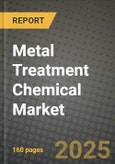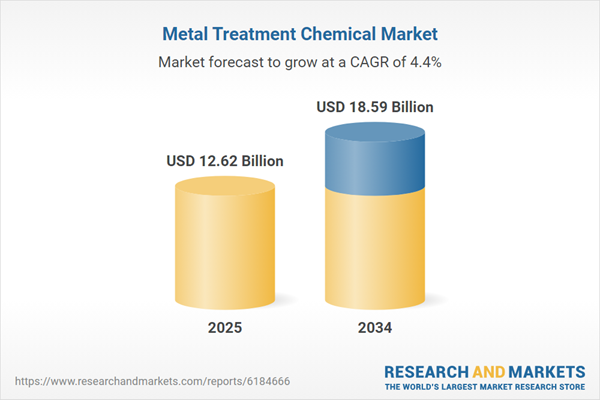Metal Treatment Chemical Market
The Metal Treatment Chemical Market spans cleaners and degreasers, pickling and passivation agents, conversion coatings (phosphate, zirconium/titanium, silane), chromate-free corrosion inhibitors, anodizing and sealing chemistries, lubricants for forming, quenchants for heat treatment, and temporary rust preventives. These chemistries prepare and protect steel, aluminum, galvanized, magnesium, copper alloys, and mixed-metal assemblies used in automotive and EV platforms, aerospace, appliances, construction, metal packaging, heavy equipment, rail, marine, and energy. Momentum is shifting from heavy-phosphate and hexavalent-chromium systems toward thin-film nano-ceramics, trivalent passivation, PFAS-free surfactants, and low-temperature, low-sludge baths that cut energy, wastewater, and maintenance. End users prioritize multi-metal compatibility, paint and powder-coat adhesion, weldability, salt-spray durability, and cosmetic appearance under increasingly demanding specifications. Digitalization is rising: inline bath analytics, automatic dosing, and IIoT dashboards stabilize quality and extend bath life, while closed-loop rinsing and microfiltration shrink water footprints. Growth headwinds include raw-material volatility, worker-exposure limits, wastewater permitting, and looming restrictions on legacy chemistries; tailwinds include EV lightweighting, galvanized body-in-white adoption, e-coat and powder-coat share gains, and modernization of fabrication shops. Competitive differentiation hinges on technical service, start-up support, corrosion testing, and global change-control discipline. Suppliers with regional blending, rapid lab turnaround, and turnkey pretreatment lines (tanks, heaters, dosing skids) win multi-plant awards. As sustainability and compliance reshape specs, the market favors chemistries that deliver equal or better adhesion and corrosion performance at lower temperature, with reduced sludge and simplified wastewater treatment - backed by robust documentation, operator training, and real-time monitoring to guarantee repeatability across diverse substrates and climates.Metal Treatment Chemical Market Key Insights
- Regulatory pivot from legacy hazards to safer systems
- Thin-film nano-ceramic pretreatments replace phosphate mass
- Multi-metal and EV body architectures raise the bar
- Water and energy intensity become C-suite metrics
- Digital QC and autonomous dosing improve repeatability
- Fabrication realities demand forgiving chemistries
- Anodizing and passivation evolve for premium aluminum
- Heat-treat and forming chemistries target cleaner exits
- Waste minimization and sludge control drive TCO
- Service, trials, and documentation win enterprise rollouts
Metal Treatment Chemical Market Reginal Analysis
North America
Automotive, appliances, construction products, and metal packaging drive demand for multi-metal pretreatments and PFAS-free cleaners. Plants pursue phosphate-to-zirconium conversions to cut sludge and utilities, while strict worker-exposure and wastewater limits shape formulations. Powder-coat and e-coat capacity additions in the U.S. South and Midwest favor turnkey pretreatment skids, digital dosing, and robust technical service to stabilize quality across multi-shift operations and seasonal temperature swings.Europe
Regulatory intensity around hazardous substances and circularity accelerates hex-chrome elimination, low-temperature baths, and water-saving rinses. Automotive and white goods emphasize mixed-metal compatibility and durable paint adhesion under salt and humidity cycling. Procurement increasingly requires environmental declarations, operator-safety evidence, and audited change control. Retrofit projects focus on compact nano-ceramic stages, heat recovery, and automated dosing to meet energy and wastewater targets.Asia-Pacific
Scale manufacturing in automotive, electronics, and fabrication markets propels high-throughput pretreatment lines. Cost-sensitive plants adopt robust alkaline cleaners and zirconium/silane systems that tolerate variable incoming quality and water hardness. Rapid EV growth expands aluminum and galvanized usage, raising demand for multi-metal adhesion packages. Local blending capacity, quick lab turnaround, and on-site start-up support are decisive in competitive tenders.Middle East & Africa
Construction metals, oil and gas fabrications, and appliance assembly require corrosion control under heat, dust, and saline air. Users seek cleaners and conversion coatings that perform with challenging make-up water and limited wastewater infrastructure. Vendors offering low-sludge, low-temperature systems with simple controls, strong field support, and training gain traction as regional coating lines modernize.South & Central America
Appliance, automotive, and building products plants prioritize uptime, accessible service, and affordable chemistries that handle mixed substrates. Upgrades focus on replacing phosphate with nano-ceramics, improving rinsing efficiency, and standardizing QC to reduce repaint rates. Distributors that stock locally, provide operator training, and support wastewater optimization help manufacturers meet rising durability expectations while managing cost and regulatory constrainMetal Treatment Chemical Market Segmentation
By Type
- Cleaners
- Lubricants and coolants
- Conversion coatings
- Rust and scale removers
- Others
By Application
- Automotive
- Manufacturing
- Construction
- Aerospace
- Metalworking and Others
Key Market players
Henkel, BASF (Chemetall), Nihon Parkerizing, Quaker Houghton, FUCHS, PPG Industries, Axalta Coating Systems, Atotech (MKS Instruments), MacDermid Enthone (Element Solutions Inc.), NOF Metal Coatings, SurTec (Freudenberg), DuBois Chemicals, Chemische Werke Kluthe, Hubbard-Hall, Bulk Chemicals Inc. (BCI Surface Technologies), Cortec Corporation, Daubert Chemical Company, Italmatch Chemicals, Birchwood Technologies, A Brite CompanyMetal Treatment Chemical Market Analytics
The report employs rigorous tools, including Porter’s Five Forces, value chain mapping, and scenario-based modelling, to assess supply-demand dynamics. Cross-sector influences from parent, derived, and substitute markets are evaluated to identify risks and opportunities. Trade and pricing analytics provide an up-to-date view of international flows, including leading exporters, importers, and regional price trends.Macroeconomic indicators, policy frameworks such as carbon pricing and energy security strategies, and evolving consumer behaviour are considered in forecasting scenarios. Recent deal flows, partnerships, and technology innovations are incorporated to assess their impact on future market performance.
Metal Treatment Chemical Market Competitive Intelligence
The competitive landscape is mapped through proprietary frameworks, profiling leading companies with details on business models, product portfolios, financial performance, and strategic initiatives. Key developments such as mergers & acquisitions, technology collaborations, investment inflows, and regional expansions are analyzed for their competitive impact. The report also identifies emerging players and innovative startups contributing to market disruption.Regional insights highlight the most promising investment destinations, regulatory landscapes, and evolving partnerships across energy and industrial corridors.
Countries Covered
- North America - Metal Treatment Chemical market data and outlook to 2034
- United States
- Canada
- Mexico
- Europe - Metal Treatment Chemical market data and outlook to 2034
- Germany
- United Kingdom
- France
- Italy
- Spain
- BeNeLux
- Russia
- Sweden
- Asia-Pacific - Metal Treatment Chemical market data and outlook to 2034
- China
- Japan
- India
- South Korea
- Australia
- Indonesia
- Malaysia
- Vietnam
- Middle East and Africa - Metal Treatment Chemical market data and outlook to 2034
- Saudi Arabia
- South Africa
- Iran
- UAE
- Egypt
- South and Central America - Metal Treatment Chemical market data and outlook to 2034
- Brazil
- Argentina
- Chile
- Peru
Research Methodology
This study combines primary inputs from industry experts across the Metal Treatment Chemical value chain with secondary data from associations, government publications, trade databases, and company disclosures. Proprietary modeling techniques, including data triangulation, statistical correlation, and scenario planning, are applied to deliver reliable market sizing and forecasting.Key Questions Addressed
- What is the current and forecast market size of the Metal Treatment Chemical industry at global, regional, and country levels?
- Which types, applications, and technologies present the highest growth potential?
- How are supply chains adapting to geopolitical and economic shocks?
- What role do policy frameworks, trade flows, and sustainability targets play in shaping demand?
- Who are the leading players, and how are their strategies evolving in the face of global uncertainty?
- Which regional “hotspots” and customer segments will outpace the market, and what go-to-market and partnership models best support entry and expansion?
- Where are the most investable opportunities - across technology roadmaps, sustainability-linked innovation, and M&A - and what is the best segment to invest over the next 3-5 years?
Your Key Takeaways from the Metal Treatment Chemical Market Report
- Global Metal Treatment Chemical market size and growth projections (CAGR), 2024-2034
- Impact of Russia-Ukraine, Israel-Palestine, and Hamas conflicts on Metal Treatment Chemical trade, costs, and supply chains
- Metal Treatment Chemical market size, share, and outlook across 5 regions and 27 countries, 2023-2034
- Metal Treatment Chemical market size, CAGR, and market share of key products, applications, and end-user verticals, 2023-2034
- Short- and long-term Metal Treatment Chemical market trends, drivers, restraints, and opportunities
- Porter’s Five Forces analysis, technological developments, and Metal Treatment Chemical supply chain analysis
- Metal Treatment Chemical trade analysis, Metal Treatment Chemical market price analysis, and Metal Treatment Chemical supply/demand dynamics
- Profiles of 5 leading companies - overview, key strategies, financials, and products
- Latest Metal Treatment Chemical market news and developments
Additional Support
With the purchase of this report, you will receive:- An updated PDF report and an MS Excel data workbook containing all market tables and figures for easy analysis.
- 7-day post-sale analyst support for clarifications and in-scope supplementary data, ensuring the deliverable aligns precisely with your requirements.
- Complimentary report update to incorporate the latest available data and the impact of recent market developments.
This product will be delivered within 1-3 business days.
Table of Contents
Companies Mentioned
- Henkel
- BASF (Chemetall)
- Nihon Parkerizing
- Quaker Houghton
- FUCHS
- PPG Industries
- Axalta Coating Systems
- Atotech (MKS Instruments)
- MacDermid Enthone (Element Solutions Inc.)
- NOF Metal Coatings
- SurTec (Freudenberg)
- DuBois Chemicals
- Chemische Werke Kluthe
- Hubbard-Hall
- Bulk Chemicals Inc. (BCI Surface Technologies)
- Cortec Corporation
- Daubert Chemical Company
- Italmatch Chemicals
- Birchwood Technologies
- A Brite Company
Table Information
| Report Attribute | Details |
|---|---|
| No. of Pages | 160 |
| Published | November 2025 |
| Forecast Period | 2025 - 2034 |
| Estimated Market Value ( USD | $ 12.62 Billion |
| Forecasted Market Value ( USD | $ 18.59 Billion |
| Compound Annual Growth Rate | 4.4% |
| Regions Covered | Global |
| No. of Companies Mentioned | 20 |





![Metal Surface Treatment Chemical Market: Trends, Opportunities and Competitive Analysis [2024-2030] - Product Image](http://www.researchandmarkets.com/product_images/12371/12371627_60px_jpg/metal_surface_treatment_chemical_market.jpg)



